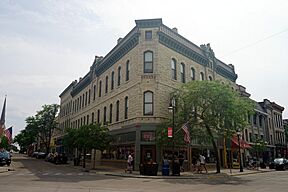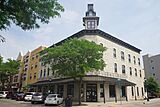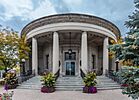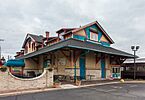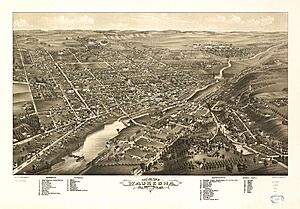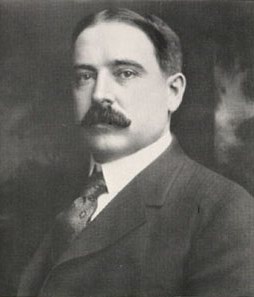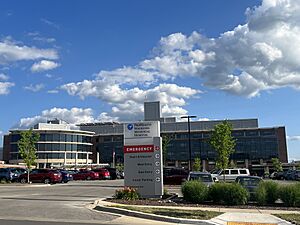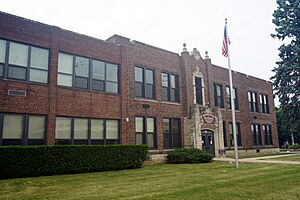Waukesha, Wisconsin facts for kids
Quick facts for kids
Waukesha, Wisconsin
|
|
|---|---|
|
Downtown Waukesha
Courthouse Complex
National Hotel
Waukesha Post Office
Waukesha station
|
|
| Nickname(s):
Spring City, Saratoga of the West, Guitartown
|
|
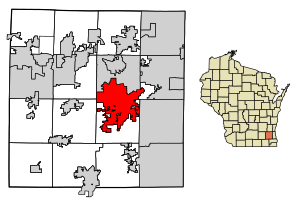
Location of Waukesha in Waukesha County, Wisconsin
|
|
| Country | United States |
| State | Wisconsin |
| County | Waukesha |
| Area | |
| • Total | 25.80 sq mi (66.83 km2) |
| • Land | 25.53 sq mi (66.12 km2) |
| • Water | 0.27 sq mi (0.70 km2) 1.04% |
| Population
(2020)
|
|
| • Total | 71,158 |
| • Estimate
(2022)
|
70,454 |
| • Rank | 7th in Wisconsin |
| • Density | 2,758.1/sq mi (1,064.76/km2) |
| Time zone | UTC−6 (Central) |
| • Summer (DST) | UTC−5 (Central) |
| ZIP Codes |
53186-53189
|
| Area code(s) | 262 |
| FIPS code | 55-84250 |
Waukesha (pronounced WAW-kish-aw) is a city in Wisconsin, United States. It is the main city, or county seat, of Waukesha County. The city is located along the Fox River. In 2020, about 71,158 people lived there. This makes it the seventh-largest city in Wisconsin. Waukesha is part of the larger Milwaukee metropolitan area. The city is next to the Village of Waukesha.
Contents
History of Waukesha
The area where Waukesha is today was first settled by people from Europe and America in 1834. Morris D. Cutler was the first settler. When these first settlers arrived, the land was covered with thick forests and wild prairies. The settlers worked hard to create farms, build roads, and set up government buildings. They also started mail routes.
Many of the first people who founded Waukesha came from New England states like Connecticut and Massachusetts. Some also came from upstate New York. These settlers were often called "Yankees." They were descendants of the English Puritans who settled New England in the 1600s. They moved west into the Northwest Territory in the early 1800s. Many arrived after the Erie Canal was finished and the Black Hawk War ended.
These New Englanders brought their values with them. They cared a lot about education and started many schools. They also strongly supported ending slavery. Most of them belonged to the Congregationalist Church. Waukesha, like much of Wisconsin, kept many parts of early New England culture for a long time.
By 1846, the area became a town called Prairie Village. Soon after, its name changed to Prairieville. On February 8, 1847, the town was renamed "Waukesha." On January 10, 1852, Prairieville became a village. In 1896, it officially became a city. John Brehm was the first mayor of Waukesha, serving from January to April 1896.
Many Welsh immigrants settled in Waukesha starting in the 1840s. Large numbers arrived in the late 1800s and early 1900s. They became one of the biggest ethnic groups in the city. Around the same time, many Belgian and Serbian families also moved to Waukesha. More Serbian immigrants arrived after the Yugoslav Wars in the 1990s.
Origin of the Name "Waukesha"
The name "Waukesha" likely comes from the Ojibwe language word Waagoshag, which means "foxes." It might also come from the Potawatomi language name Wau-tsha. Wau-tsha was the leader of the local Native American tribe when the first European settlers arrived. Early historian Increase A. Lapham confirmed this. He said the Algonquian word for "fox" was pishtaka. Morris Cutler, an early settler, described Wau-tsha as "tall and athletic, proud in his bearing, dignified and friendly."
"Spring City" Nickname
Waukesha was once famous for its very clean and good-tasting spring water. People called it a "spa town." This is why the city earned the nicknames "Spring City" and "Saratoga of the West."
Matthew Laflin, an early pioneer, helped make Waukesha a popular resort. He owned a large resort called the Fountain Spring House. In 1868, Colonel Richard Dunbar discovered the special properties of what he called the Bethesda Spring. He believed the water had healing benefits.
By 1872, Waukesha became very popular. Newspapers reported that many visitors came to the city. They stayed in hotels and private homes, hoping to benefit from the "marvelous waters."
The "healing waters" were so important that there was a plan to build a pipeline. This pipeline would carry water from Waukesha to Chicago for the 1893 Columbian Exposition. However, the plan was too expensive and was never finished.
Richard Warren Sears, who founded Sears and Roebuck, may have been drawn to Waukesha by its waters. He retired in 1908 due to poor health. He spent his last years on his large farm near Waukesha. Sears passed away in Waukesha in 1914.
Over time, the natural springs became polluted, and some even dried up. Water from the ground also had high levels of radium. In 2013, Waukesha asked for permission to use water from Lake Michigan. Since Waukesha is outside the lake's natural area, it needed approval from eight state governors. In June 2016, the governors approved Waukesha's request. In 2023, the city started getting water from Lake Michigan through new pipelines.
Football History in Waukesha
An important moment in American sports happened in Waukesha on September 5, 1906. Carroll College (now Carroll University) played against the football team from St. Louis University. In that game, SLU player Bradbury Robinson threw the first legal forward pass in football history. The Carroll players and local fans were surprised. St. Louis University won the game 22–0.
Project Nike Missile Site
During the Cold War, Waukesha County had three Nike Missile batteries. These were located in Waukesha, Muskego, and Lannon. In Waukesha, the U.S. Army and later the Wisconsin National Guard ran a control center from 1956 to 1970. This center was at what is now Hillcrest Park. Missile sites were near Cleveland Avenue and Hwy 164. They first held Ajax missiles with regular warheads. Later, they held nuclear-equipped Hercules warheads. The Hercules warhead had a similar power to the atomic bomb dropped on Nagasaki in World War II. There are efforts to preserve the Hillcrest Park site as a museum. This museum would honor Cold War veterans and remember this long conflict.
Geography and Climate
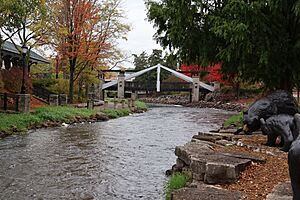
Waukesha is located in southeastern Wisconsin. According to the United States Census Bureau, the city covers about 25.07 square miles (64.93 square kilometers). Most of this area, about 24.81 square miles (64.26 square kilometers), is land. The remaining 0.26 square miles (0.67 square kilometers) is water.
| Climate data for Waukesha WWTP, Wisconsin (1991–2020 normals, extremes 1894–present) | |||||||||||||
|---|---|---|---|---|---|---|---|---|---|---|---|---|---|
| Month | Jan | Feb | Mar | Apr | May | Jun | Jul | Aug | Sep | Oct | Nov | Dec | Year |
| Record high °F (°C) | 62 (17) |
66 (19) |
82 (28) |
91 (33) |
101 (38) |
101 (38) |
109 (43) |
102 (39) |
101 (38) |
88 (31) |
78 (26) |
68 (20) |
109 (43) |
| Mean daily maximum °F (°C) | 27.7 (−2.4) |
31.5 (−0.3) |
43.0 (6.1) |
55.3 (12.9) |
67.3 (19.6) |
77.4 (25.2) |
81.4 (27.4) |
79.8 (26.6) |
72.9 (22.7) |
60.0 (15.6) |
45.0 (7.2) |
33.0 (0.6) |
56.2 (13.4) |
| Daily mean °F (°C) | 19.7 (−6.8) |
23.0 (−5.0) |
33.5 (0.8) |
45.1 (7.3) |
56.6 (13.7) |
66.5 (19.2) |
70.9 (21.6) |
69.4 (20.8) |
62.0 (16.7) |
49.9 (9.9) |
36.7 (2.6) |
25.5 (−3.6) |
46.6 (8.1) |
| Mean daily minimum °F (°C) | 11.6 (−11.3) |
14.6 (−9.7) |
24.0 (−4.4) |
34.8 (1.6) |
45.8 (7.7) |
55.6 (13.1) |
60.3 (15.7) |
58.9 (14.9) |
51.1 (10.6) |
39.8 (4.3) |
28.3 (−2.1) |
18.1 (−7.7) |
36.9 (2.7) |
| Record low °F (°C) | −27 (−33) |
−28 (−33) |
−14 (−26) |
7 (−14) |
25 (−4) |
29 (−2) |
41 (5) |
35 (2) |
25 (−4) |
7 (−14) |
−9 (−23) |
−28 (−33) |
−28 (−33) |
| Average precipitation inches (mm) | 1.60 (41) |
1.71 (43) |
1.93 (49) |
3.65 (93) |
3.97 (101) |
4.88 (124) |
3.99 (101) |
4.18 (106) |
3.27 (83) |
2.92 (74) |
2.15 (55) |
1.70 (43) |
35.95 (913) |
| Average snowfall inches (cm) | 10.4 (26) |
10.1 (26) |
4.6 (12) |
1.1 (2.8) |
0.0 (0.0) |
0.0 (0.0) |
0.0 (0.0) |
0.0 (0.0) |
0.0 (0.0) |
0.1 (0.25) |
1.8 (4.6) |
8.8 (22) |
36.9 (94) |
| Average precipitation days (≥ 0.01 in) | 9.4 | 8.2 | 7.6 | 11.0 | 12.8 | 11.2 | 8.9 | 9.2 | 8.6 | 9.8 | 8.5 | 9.4 | 114.6 |
| Average snowy days (≥ 0.1 in) | 6.8 | 6.0 | 3.2 | 0.9 | 0.0 | 0.0 | 0.0 | 0.0 | 0.0 | 0.1 | 1.3 | 5.4 | 23.7 |
| Source: NOAA | |||||||||||||
People of Waukesha
| Historical population | |||
|---|---|---|---|
| Census | Pop. | %± | |
| 1860 | 1,456 | — | |
| 1870 | 2,633 | 80.8% | |
| 1880 | 2,969 | 12.8% | |
| 1890 | 6,321 | 112.9% | |
| 1900 | 7,419 | 17.4% | |
| 1910 | 8,740 | 17.8% | |
| 1920 | 12,558 | 43.7% | |
| 1930 | 17,176 | 36.8% | |
| 1940 | 19,242 | 12.0% | |
| 1950 | 21,233 | 10.3% | |
| 1960 | 30,004 | 41.3% | |
| 1970 | 40,271 | 34.2% | |
| 1980 | 50,365 | 25.1% | |
| 1990 | 56,894 | 13.0% | |
| 2000 | 64,825 | 13.9% | |
| 2010 | 70,718 | 9.1% | |
| 2020 | 71,158 | 0.6% | |
| Source: U.S. Census | |||
2020 Census Information
In 2020, Waukesha had a population of 71,158 people. There were 31,280 homes. The city's population density was about 2,788 people per square mile (1,076 people per square kilometer).
The people of Waukesha come from many different backgrounds.
- About 14.0% of the population identified as Hispanic or Latino.
- When looking at race, about 78.6% were White.
- About 3.5% were Black or African American.
- About 3.4% were Asian.
- About 0.5% were Native American.
- About 4.4% were from other races, and 9.6% were from two or more races.
The average income for a household in Waukesha was about $65,688. For families, the average income was about $84,972. The average income per person in the city was $34,785. About 11.1% of the population lived below the poverty line. This included 18.1% of those under 18 years old.
Most adults in Waukesha have a good education. About 92.3% of people aged 25 and older have graduated from high school. Also, 38.7% have earned a bachelor's degree or higher.
2010 Census Information
In 2010, Waukesha had 70,718 people living in 28,295 households. The population density was about 2,850 people per square mile (1,100 people per square kilometer).
The racial makeup of the city in 2010 was:
- 88.1% White
- 2.3% African American
- 0.4% Native American
- 3.5% Asian
- 3.5% from other races
- 2.1% from two or more races.
About 12.1% of the population was Hispanic or Latino.
In 2010, about 32.1% of households had children under 18. About 46.9% were married couples. The average household size was 2.40 people, and the average family size was 3.02 people. The median age in the city was 34.2 years.
Economy and Jobs
Waukesha has many important employers that provide jobs for its residents. Here are some of the top employers in the city:
| # | Employer | # of Employees |
|---|---|---|
| 1 | GE Healthcare | 2,477 |
| 2 | Waukesha Memorial Hospital | 2,149 |
| 3 | Waukesha School District | 1,800 |
| 4 | Waukesha County | 1,354 |
| 5 | Cooper Power Systems | 1,006 |
| 6 | Generac Power Systems | 759 |
| 7 | Carroll University | 742 |
| 8 | HUSCO International | 685 |
| 9 | Waukesha Electric Systems | 631 |
| 10 | City of Waukesha | 487 |
Education in Waukesha
Waukesha has a variety of schools for students of all ages.
Private Schools
Private schools in Waukesha include:
- Waukesha Catholic School System
- Catholic Memorial High School
- Mt. Calvary Lutheran School (Pre-K to 8th grade)
- Trinity Lutheran School (Pre-K to 8th grade), which is part of the WELS.
Colleges and Universities
Waukesha is home to several higher education institutions:
- The University of Wisconsin–Milwaukee at Waukesha offers two-year associate degrees. Students can then transfer to a four-year university to finish their studies.
- Waukesha County Technical College has a campus downtown.
- Carroll University is a private Presbyterian university. It opened in 1846 and is the oldest college in Wisconsin.
- One of the two New Tribes Bible Institute campuses in the United States is located in Waukesha. This school is the first part of a four-year training program for missionaries.
Transportation and Infrastructure
Getting Around Waukesha
Waukesha Metro Transit provides bus services within the city. They have both fixed routes and a dial-a-ride service. For travel between cities, you can use bus companies like Badger Bus, Flixbus, Lamers Bus Lines, and Wisconsin Coach Lines.
The Union Pacific (Chicago & North Western) Waukesha Subdivision is a railway line that ends at WI 164. Another railway line, the former Milwaukee Road line, runs through Waukesha between Milwaukee and Milton. The Soo Line's main railway from Chicago to Portal also had a major stop in Waukesha.
Water Supply
In 2023, Waukesha changed its water source. Before, the city used groundwater which had unsafe levels of radium. Now, Waukesha gets its water from Lake Michigan through a system of pipelines that are about 35 miles long.
Historic Landmarks
Waukesha has many important historic places. You can find more information about them in the National Register of Historic Places listings in Waukesha County, Wisconsin.
Notable People from Waukesha
Many interesting people have come from Waukesha. To learn more about them, you can visit the List of people from Waukesha, Wisconsin.
Sister City
Waukesha has one sister city:
See also
 In Spanish: Waukesha (Wisconsin) para niños
In Spanish: Waukesha (Wisconsin) para niños


